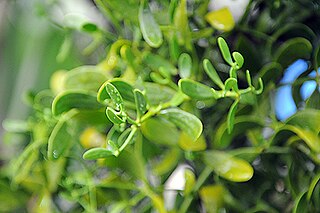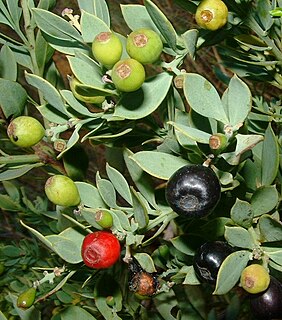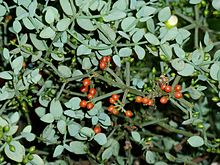
Mistletoe is the common name for obligate hemiparasitic plants in the order Santalales. They are attached to their host tree or shrub by a structure called the haustorium, through which they extract water and nutrients from the host plant. Their parasitic lifestyle has led to some dramatic changes in their metabolism.

Loranthaceae, commonly known as the showy mistletoes, is a family of flowering plants. It consists of about 75 genera and 1,000 species of woody plants, many of them hemiparasites. The three terrestrial species are Nuytsia floribunda, Atkinsonia ligustrina, and Gaiadendron punctatum Loranthaceae are primarily xylem parasites, but their haustoria may sometimes tap the phloem, while Tristerix aphyllus is almost holoparasitic. For a more complete description of the Australian Loranthaceae, see Flora of Australia online., for the Malesian Loranthaceae see Flora of Malesia.

The genus Arceuthobium, commonly called dwarf mistletoes, is a genus of 26 species of parasitic plants that parasitize members of Pinaceae and Cupressaceae in North America, Central America, Asia, Europe, and Africa. Of the 42 species that have been recognized, 39 and 21 of these are endemic to North America and the United States, respectively. They all have very reduced shoots and leaves with the bulk of the plant living under the host's bark. Recently the number of species within the genus has been reduced to 26 as a result of more detailed genetic analysis.

Viscum album is a species of mistletoe in the family Santalaceae, commonly known as European mistletoe, common mistletoe or simply as mistletoe. It is native to Europe and western and southern Asia.

Viscum is a genus of about 70–100 species of mistletoes, native to temperate and tropical regions of Europe, Africa, Asia and Australasia. Traditionally, the genus has been placed in its own family Viscaceae, but recent genetic research by the Angiosperm Phylogeny Group shows this family to be correctly placed within a larger circumscription of the sandalwood family, Santalaceae.

Vachellia karroo, commonly known as the Sweet thorn, is a species of acacia, native to southern Africa from southern Angola east to Mozambique, and south to South Africa.

Viscum cruciatum, commonly called the red-berry mistletoe, is a species of mistletoe in the family Santalaceae. It is native to Lebanon, Morocco, Palestine, Portugal, Spain, and Syria.

Ditula angustiorana, the red-barred tortrix, is a moth of the family Tortricidae found in Africa, Asia, Europe and North Africa. Other common names are the fruit-tree tortrix and the vine tortrix. The moth was first described by Adrian Hardy Haworth in 1811.

Dendrophthoe falcata is one of the hemiparasitic plants that belong to the mistletoe family Loranthaceae. It is the most common of all the mistletoes that occur in India. At the moment reports say that it has around 401 plant hosts. The genus Dendrophthoe comprises about 31 species spread across tropical Africa, Asia, and Australia among which 7 species are found in India.

Stugeta bowkeri, the Bowker's sapphire, Bowker's marbled sapphire or Bowker's tailed blue, is a butterfly of the family Lycaenidae. It is found in most of southern Africa.

Osyris compressa is a facultatively hemiparasitic, mainly South African plant of the sandalwood family, Santalaceae. Until recently, the favoured binomial name was Colpoon compressum, but around 2001, the genus Colpoon was included in Osyris on the basis of comparative DNA studies. That assignment is not final, however, and according to the Kew Gardens plant list, Colpoon compressum P.J.Bergius, though still in review, is the accepted name.

Dendrophthoe vitellina, commonly known as long-flowered- or apostle mistletoe, is a hemiparasitic plant of the mistletoe family Loranthaceae. The genus Dendrophthoe comprises about 31 species spread across tropical Africa, Asia, and Australia. Despite being collected by Joseph Banks and Daniel Solander in 1788, and depicted in Banks' Florilegium, it was not until 1860 that it was described by Ferdinand von Mueller as Loranthus vitellinus after being collected near Ipswich, and renamed by Philippe Édouard Léon Van Tieghem in 1895.
Red-berry mistletoe may refer to:

Viscum combreticola, the Combretum mistletoe, is a leafless, dioecious mistletoe shrub, occurring from southern to tropical Africa, in a broad zone following the Rift Valleys. Though it is typically a hemiparasite of Combretum species, it may also be found on Terminalia (Combretaceae), Acacia, Croton, Diplorhynchus, Dombeya, Heteropyxis, Maytenus, Melia, Strychnos or Vangueria.

Arceuthobium oxycedri, juniper dwarf mistletoe, is a hemiparasite of the family Santalaceae. It parasitizes members of the genus Juniperus, especially Juniperus oxycedrus and Juniperus communis.

Viscum minimum is a species of mistletoe in the family Santalaceae. It is a parasitic plant native to South Africa.
Tapinanthus bangwensis is a species of hemiparasitic plant in the family Loranthaceae, which is native to the tropics of western sub-Saharan Africa.

Tupeia is a monotypic genus of semi-parasitic shrubs (mistletoes) which occurs in both the North and South Islands of New Zealand. There is only one species in the genus: Tupeia antarctica. There are no synonyms.














